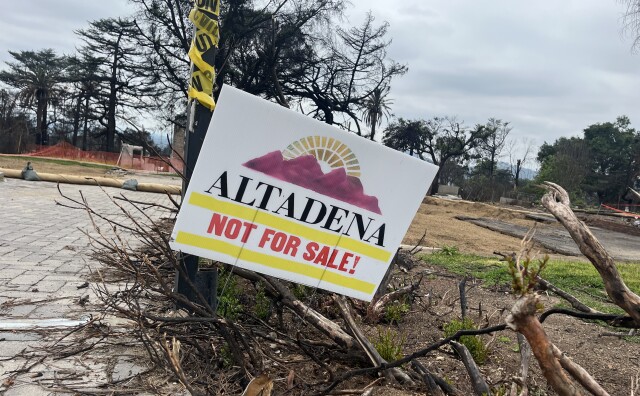Congress has cut federal funding for public media — a $3.4 million loss for LAist. We count on readers like you to protect our nonprofit newsroom. Become a monthly member and sustain local journalism.
Tiger Woods Was Driving Nearly Twice The Speed Limit When He Crashed, But Wasn’t Driving Recklessly, LASD Says

Tiger Woods was driving between 84 and 87 miles per hour on a curved stretch of Hawthorne Boulevard with a posted speed limit of 45 mph when he lost control of his car, struck the median and a sign, crossed into the opposite lanes, jumped the curb, hit a tree, went airborne and rolled before crashing down on the hillside.
That’s according to officials from the Los Angeles County Sheriff’s Department, who on Wednesday revealed the results of their investigation into the Feb. 23 single-car collision in Rolling Hills Estates near Rancho Palos Verdes. Woods, 45, was seriously injured and underwent multiple surgeries on his legs.
Woods’ car had a data recorder — basically a black box — which helped investigators piece together how fast he was driving right before the crash, and the multiple points of impact.

In this case, Woods was driving dangerously fast — and speed and safe turns don’t mix. But because no one witnessed the crash, no one else was hurt and deputies did not find any evidence of impairment, Woods will not be charged or be given a speeding ticket.
In a media briefing livestreamed this morning, Sheriff Alex Villanueva addressed social media speculation that Woods received “preferential treatment” and wasn’t scrutinized by the sheriff's department the way most drivers would be.
“There [were] no signs of impairment. Our primary concern, obviously, at the scene of the collision was his safety, and this is where you have to switch gears and make sure the person can survive and receives the medical care they need … without the signs of impairment, we don't get to the point where we can actually author a search warrant and develop the probable cause to get.”
“You have to have multiple violations considered in conjunction with one another, like multiple unsafe lane changes, passing vehicles in an unsafe manner — kind of like road rage stuff — and that did not exist here. Therefore reckless driving was not appropriate.”

Investigators do not automatically file search warrants for phone records or test drivers for drugs and alcohol. When a driver severely injures or kills someone and there’s no other witnesses or video of the crash, it’s often the driver’s word against no one else’s.
And the common use of “accident” by law enforcement and news media (uttered several times in today’s briefing) to describe crashes has a loaded history. The word was part of a campaign by early automakers to shift blame away from drivers and paint traffic injuries and deaths as unavoidable.
Most drivers don’t face felony charges over crashes — even when they injure or kill another person. That’s because of the high bar investigators and prosecutors use to establish negligence, which determines fault and accountability.
To learn more about crash investigations, driver accountability, speeding and how we talk about traffic violence, explore my reporting here:
- Death In A Crosswalk: The Killing Of A 4-Year-Old Shows LA's Failure To Stop Traffic Violence
- There's A New Push To Put The Brakes On LA's Rising Speed Limits
- 'Car Accident' Or 'Traffic Violence'? The Way We Talk About Crashes Is Evolving
- Do We Need Police To Curb LA's Traffic Violence? Some Cities Are Saving Lives Without Them
Our news is free on LAist. To make sure you get our coverage: Sign up for our daily newsletters. To support our non-profit public service journalism: Donate Now.
As Editor-in-Chief of our newsroom, I’m extremely proud of the work our top-notch journalists are doing here at LAist. We’re doing more hard-hitting watchdog journalism than ever before — powerful reporting on the economy, elections, climate and the homelessness crisis that is making a difference in your lives. At the same time, it’s never been more difficult to maintain a paywall-free, independent news source that informs, inspires, and engages everyone.
Simply put, we cannot do this essential work without your help. Federal funding for public media has been clawed back by Congress and that means LAist has lost $3.4 million in federal funding over the next two years. So we’re asking for your help. LAist has been there for you and we’re asking you to be here for us.
We rely on donations from readers like you to stay independent, which keeps our nonprofit newsroom strong and accountable to you.
No matter where you stand on the political spectrum, press freedom is at the core of keeping our nation free and fair. And as the landscape of free press changes, LAist will remain a voice you know and trust, but the amount of reader support we receive will help determine how strong of a newsroom we are going forward to cover the important news from our community.
Please take action today to support your trusted source for local news with a donation that makes sense for your budget.
Thank you for your generous support and believing in independent news.

-
People moving to Los Angeles are regularly baffled by the region’s refrigerator-less apartments. They’ll soon be a thing of the past.
-
Experts say students shouldn't readily forgo federal aid. But a California-only program may be a good alternative in some cases.
-
The program is for customers in communities that may not be able to afford turf removal or water-saving upgrades.
-
More than half of sales through September have been to corporate developers. Grassroots community efforts continue to work to combat the trend.
-
The bill would increase penalties for metal recyclers who possess or purchase metal used in public infrastructure.
-
The new ordinance applies to certain grocers operating in the city and has led to some self-checkout lanes to shutter.







